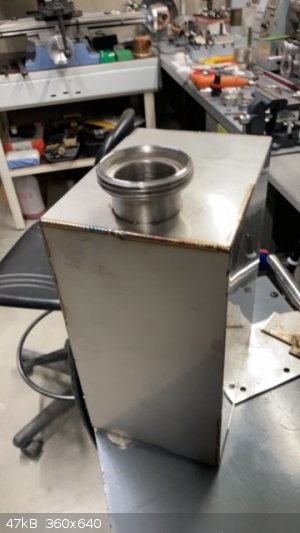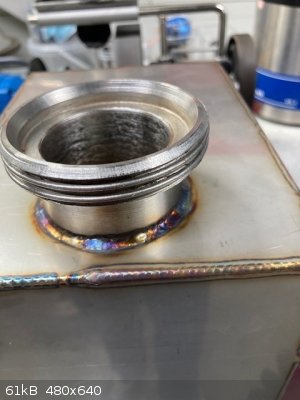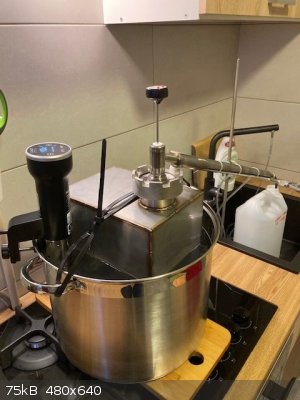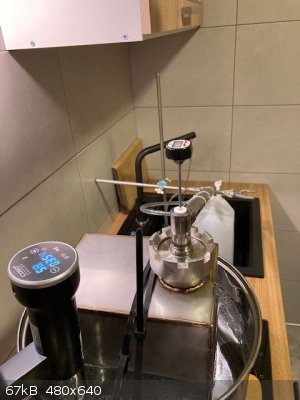alchemizt
Harmless

Posts: 36
Registered: 28-1-2019
Member Is Offline
|
|
Stainless steel solvent still?
I want to build a general purpose solvent recycling system. There are some good videos on building distillers on YouTube:
https://youtu.be/k-j4Rhymqsk
I want to build a distiller that I can use to recycle used solvents like DCM, acetone, petroleum ether, diethyl ether, toluene etc. Do I'd like to
adapt one of these types of stainless steel distillers. What parts of an alcohol distiller need to be changed to make it suitable for solvents?
Firstly, they use silicone gaskets. Various solvents will dissolve silicon wont they? Any idea how I would make a chemical resistant gasket? Some of
them also use silicone tubing to pass the vapours from the vessel to the condenser so Id need to replace that with copper tubing?
Second, the electrical heating element. I like that because you can control the heat by regulating the voltage. Is an electrical heating element safe
to use with flammable solvents like petroleum ether or diethyl ether?
Some of these videos use hot glue guns to seal fittings, Im guessing that wont work for solvents either.
Has anyone here built a stainless steel distiller for distilling solvents?
|
|
|
macckone
International Hazard
    
Posts: 2159
Registered: 1-3-2013
Location: Over a mile high
Member Is Offline
Mood: Electrical
|
|
Use copper unless you have a specific reason not to.
Distillers generally use triclamp connectors.
The only thing you would need to change if you buy a commercial one is the seals and they sell teflon seals.
I used a 1" pipe packed with rings for the fractionating column.
Then 1/2" pipe with 3/4" pipe as the condenser and standard fittings with slight modification (removing the stops) for the condenser shell.
I used screw fittings for the top of the fractionating and condenser columns.
I also included a reflux tube that allows me to regulate the reflux, it is a 1/2" pass through cooling tube at the top of the column.
I use mine for one specific solvent but it is 100% metal.
The only place I used anything else is on the boiling vessel, I used some silicone to seal leaks.
The solvent I use on that piece of equipment is pretty neutral to silicone and I used a food contact rated variety.
Most of the distilling guys are adamant about only using metal, cork or ptfe for sealing.
|
|
|
Fantasma4500
International Hazard
    
Posts: 1677
Registered: 12-12-2012
Location: Dysrope (aka europe)
Member Is Offline
Mood: dangerously practical
|
|
i would go for silicone, you can probably make your own seals by just dumping some silicone glue on aluminium foil then treating that with HCl to
remove the, supposedly stuck aluminium foil
for home built i would go for a flange
induction heating would probably be cool, if its a stainless rig you could just throw in a piece of steel at the bottom, or a bunch of screws or
whatever, honestly if it sticks up a bit from the bottom it would carry the heat into the solvent better, i would expect it to kick off a bit faster
like that
temperature control would be cool, but im not sure if induction heaters are possible to adjust well?
i would naturally go for steel, i cant imagine how you would clamp copper together or even construct it, and mind you that would be really expensive
to build too, with steel you could probably give it a zinc electrolating on the inside or maybe something as easy as waterglass would do
ive seen steel vessels coated with blue-tinted sodium silicate to handle diabolic stuff like sulfuryl chloride
maybe you could throw in an dip heater device and have that welded in shut, put a volt limitor on that thing maybe with a knob? the hot fumes should
carry the heat wherever it needs to go and having the heating device on the inside would save you a lot of space
you could go for stainless steel but it absolutely sucks to fabricate anything with, compared to basic carbon steel and even if you decide to distill
water it will probably take you a very long time to fully corrode a 2mm steel pipe
for reference theres still cars driving around, 20 years old with only 2mm thick exhaust pipes
|
|
|
SWIM
National Hazard
   
Posts: 970
Registered: 3-9-2017
Member Is Offline
|
|
Some large pressure cookers have a spigot fit between the pot ant the lid.
If you find one of these you can use it as a boiler and have no gasket worries there.
The rest can use threaded fittings if you don't want to weld, braze or connect with silver solder (use plumber's tape)
If you use copper tubing you can solder threaded fittings on where you want to be able to take it apart and just solder the rest of the joints with
food grade solder (no lead contamination).
I am assuming you want to make one up cheaply like in the video you posted.
How big a still are you planning?
|
|
|
alchemizt
Harmless

Posts: 36
Registered: 28-1-2019
Member Is Offline
|
|
Is copper superior to steel? Whats the reasoning behind this? My only reason to use stainless steel is its easy to find steel pots. I'll look into
finding a copper vessel.
|
|
|
markx
National Hazard
   
Posts: 645
Registered: 7-8-2003
Location: Northern kingdom
Member Is Offline
Mood: Very Jolly
|
|
Copper is easier to work and join by brazing or soldering, but it shall be more reactive towards some compounds compared to SS. Also it stains and
corrodes slowly...so in that sense SS is superior and I personally tend to prefer stainless if possible. It is just a way more sturdy and permanent
solution.
A small pot type solvent recovery still I made from stainless and tig welded it all together:
  
 
Used it to recover acetone from preparation process of hydrophobic lightweight filler materials....
Exact science is a figment of imagination.......
|
|
|
macckone
International Hazard
    
Posts: 2159
Registered: 1-3-2013
Location: Over a mile high
Member Is Offline
Mood: Electrical
|
|
Copper also has better conductivity.
A lot of the professionally produced stills use a stainless pot with a tri-clamp fitting and then copper pipe for the tower and condenser.
You can also buy fractionating models with bubble plate designs but they are quite expensive compared to a packed column.
|
|
|
markx
National Hazard
   
Posts: 645
Registered: 7-8-2003
Location: Northern kingdom
Member Is Offline
Mood: Very Jolly
|
|
Quote: Originally posted by macckone  | Copper also has better conductivity.
A lot of the professionally produced stills use a stainless pot with a tri-clamp fitting and then copper pipe for the tower and condenser.
You can also buy fractionating models with bubble plate designs but they are quite expensive compared to a packed column. |
True that! Copper works wonders as far as heat conductivity is concerned. Curiously I have not yet seen a "commercial craft brewing column" with
proper reflux regulation stage....all of them seem to "half arse" with partial dephlegmators that provide a somewhat controllable reflux by condensing
part of the vapour.
Exact science is a figment of imagination.......
|
|
|
alchemizt
Harmless

Posts: 36
Registered: 28-1-2019
Member Is Offline
|
|
Thanks for all the replies, its given me a lot of insight! I cant respond with quotes properly because Im on a cellphone.
Antiswat: So silicone has good solvent resistance? I cant find any of those rubber gaskets you use to seal buchner flasks in place in vacuum flasks,
so I found some silicone they use to make models, I'm going to try make silicone gaskets for me buchner funnels. I may use it to make a gasket for the
distiller too..
|
|
|
macckone
International Hazard
    
Posts: 2159
Registered: 1-3-2013
Location: Over a mile high
Member Is Offline
Mood: Electrical
|
|
alchemizt,
silicone is resistant to some solvents.
Alcohols (specifically lower alcohols) won't damage it.
Ketones and hydrocarbons (including long chain alcohols) will destroy silicone at high temperatures.
Check your compatibility. The following is a specific type of silicone hose but it will be representative.
https://www.parker.com/Literature/Fluid%20Transfer%20Hose%20...
There are number of ways to improve resistance of specific silicones, including adding inert filler that will help prevent degradation and coating the
silicone with something like ptfe tape (teflon) or polyimide film (kapton)
|
|
|
Fantasma4500
International Hazard
    
Posts: 1677
Registered: 12-12-2012
Location: Dysrope (aka europe)
Member Is Offline
Mood: dangerously practical
|
|
look up silicone chemical compatability
but theres probably a bunch of different types of silicones, so its gonna be a guesstimate anyhow
one guy i know distilled WFNA through silicone hosing, and it worked for about a day at a time before he had to replace it, its quite sturdy stuff no
doubt
silicones are excellently heat stable, to burn through it you need to use like temperature of hotglowing steel, ive used that to punch holes in
silicone for watertightening some bolt-configuration
|
|
|
markx
National Hazard
   
Posts: 645
Registered: 7-8-2003
Location: Northern kingdom
Member Is Offline
Mood: Very Jolly
|
|
Quote: Originally posted by alchemizt  | Thanks for all the replies, its given me a lot of insight! I cant respond with quotes properly because Im on a cellphone.
Antiswat: So silicone has good solvent resistance? I cant find any of those rubber gaskets you use to seal buchner flasks in place in vacuum flasks,
so I found some silicone they use to make models, I'm going to try make silicone gaskets for me buchner funnels. I may use it to make a gasket for the
distiller too.. |
Silicones, once cured, have rather good solvent resistance towards milder compounds like hydrocarbon mixtures and alcohols. But more agressive stuff
like certain esters, ethers, ketones and DCM like solvents tend to affect silicones at higher temps quite readily. Also it is worth to mention that
"harware store variety" silicones are heavily diluted nowadays and have modest chemical resistance. I would suggest silicone that is specifically
meant for glueing of glass. These tend to be less diluted and have a better chance of standing against the action of agressive solvents.
Your best bet would of course be PTFE based gaskets, couplers and tubing. These are "bombproof" as far as solvent resistance goes and always my first
choice when possible. But they can be rather pricey in ready to use condition, if one has no means to machine the needed parts. Raw round stock PTFE
can be found for a rather reasonable cost though...
Exact science is a figment of imagination.......
|
|
|
Tsjerk
International Hazard
    
Posts: 3022
Registered: 20-4-2005
Location: Netherlands
Member Is Offline
Mood: Mood
|
|
With SS you just have to be careful with chloride in combination with acid.
|
|
|
macckone
International Hazard
    
Posts: 2159
Registered: 1-3-2013
Location: Over a mile high
Member Is Offline
Mood: Electrical
|
|
markx,
automotive silicones are very heat and chemical resistant. The stuff you buy at lowes and home depot is for tubs and windows not heavy use.
Some of the 'dilutants' like silica actually help chemical resistance.
|
|
|
markx
National Hazard
   
Posts: 645
Registered: 7-8-2003
Location: Northern kingdom
Member Is Offline
Mood: Very Jolly
|
|
Quote: Originally posted by macckone  | markx,
automotive silicones are very heat and chemical resistant. The stuff you buy at lowes and home depot is for tubs and windows not heavy use.
Some of the 'dilutants' like silica actually help chemical resistance. |
So-so....results can vary, a trial and error approach is to be advised when selecting the product  ! !
E.g. we used a certain type of red automotive gasket silicone to seal high temp rotary bed chlorinating reactor heads into quartz tubes. For a period
the product worked really excellent and outlasted the quartz tube itself, but then apparently a formulation change was applied and the sealant started
to degrade quickly, causing a lot of grief and extra work.
Exact science is a figment of imagination.......
|
|
|
Fyndium
International Hazard
    
Posts: 1192
Registered: 12-7-2020
Location: Not in USA
Member Is Offline
|
|
Order 1mm PTFE sheet and cut your gaskets from it. I have used them for my flanges with excellent results. Half of solvents will readily eat silicone,
rest of them will do so when boiling hot, and it will literally crumble in your hands in no time and likely contaminate your solvents on the way.
Silicone is really useful only for water and food grade stuff.
For bigger gaskets and other purposes, thicker sheet and PTFE round bars can also be found in very competitive cost. Silicone stuff costs surprisingly
much compared to how poorly it performs.
I have used ordinary transparent PVC/PU tube as a sacrificial tubing for some reactions such as chlorinating and ammonia generation. It will corrode
the tube and make it opaque, but at least these doesn't seem to affect it's structural rigidity and it will last several hours, and it is very cheap
so it can be replaced with no issues. It can also be carefully heated to stretch and seal it against different diameter connectors.
Stainless steel is excellent material if you can weld it. I have a bokakob made out of it and it works perfect.
|
|
|
macckone
International Hazard
    
Posts: 2159
Registered: 1-3-2013
Location: Over a mile high
Member Is Offline
Mood: Electrical
|
|
for seals you can also wrap normal stuff in teflon tape.
If you do it right you effectively get a teflon tape gasket.
Another source of teflon is bar-b-que mats.
They are generally teflon impregnated fiberglass.
And on the silicone front, yes, formulations change and those changes are not announced and can cause failure of a product that once worked. For the
product markx is referencing, my guess is they increased the high temperature resistance while sacrificing chlorine resistance, which for his
application is an obvious fail.
Another compound that works well for sealing is exhaust system sealing putty.
It is usually a mix of sodium silicate and kaolin clay 20/80 - 30/70 sometimes with fumed silica added.
It is easy to mix up yourself, and it seals pretty well but it does not come off easily.
|
|
|
Fyndium
International Hazard
    
Posts: 1192
Registered: 12-7-2020
Location: Not in USA
Member Is Offline
|
|
I actually used teflon tape before I got the 1mm PTFE sheet which I just wrapped to the flange surfaces and clamped it down with bolts and it worked
great.
Moonshiners just use paste of flour and water to seal stuff. Dirty and gunky, but works, for alcohol.
|
|
|
markx
National Hazard
   
Posts: 645
Registered: 7-8-2003
Location: Northern kingdom
Member Is Offline
Mood: Very Jolly
|
|
Quote: Originally posted by Fyndium  | I actually used teflon tape before I got the 1mm PTFE sheet which I just wrapped to the flange surfaces and clamped it down with bolts and it worked
great.
Moonshiners just use paste of flour and water to seal stuff. Dirty and gunky, but works, for alcohol. |
Ya, PTFE tape can be manipulated, wound, woven, pressed into many forms to make a seal or gasket. The heavier PTFE (maxi) tape is quite good for this
purpose and can be of great help in a pinch.
I've once tried the flour putty method just for funsies on a slightly leaky fractionation column section and I'm under the impression that this is
probably mostly a folk legend. It is messy, gunky and a pain to work with, but does not really seal anything 
Exact science is a figment of imagination.......
|
|
|
Tsjerk
International Hazard
    
Posts: 3022
Registered: 20-4-2005
Location: Netherlands
Member Is Offline
Mood: Mood
|
|
I even use PTFE tape to seal my Buchner funnel when doing vacuum filtrations. The vacuum pulls everything tight and it leaks minimally. As long as you
can tighten the seal somehow PTFE works great.
|
|
|
Mush
National Hazard
   
Posts: 632
Registered: 27-12-2008
Member Is Offline
Mood: No Mood
|
|
I would use threaded Stainless Steel fittings. For seal teflon tape spec for oil and petrol (automotive applications) . Std teflon tape should be
fine too.
Teflon® tape is so versatile it can be used at temperatures ranging from -270°C to 260°C. PTFE has an outstanding chemical resistance and is
unaffected by all known chemicals except alkali metals and under certain conditions, fluorine.
If u can tig weld or stick weld with stainless steel rod limit the sky. Rods are expensive for mma but easier to learn than tig welding imo.
Markx's distiller is a nice example what can be achieved with a welder.
Stick welding stainless
https://www.youtube.com/watch?v=Gr9G-XzRsS4
Learn secrets of Welding Thin Stainless steel Sheet
https://www.youtube.com/watch?v=RFIZFYjaOog
Standard inverter welder cipo one will do the job.
Heating, I would build a steam heated double jacketed mini reactor out of standard stainless steel kitchenware (mixing bowl etc). So it could be
used for refluxing,cooling, distillation pretty much for any type of lab application.
Cooler:
Distiller External Cooling Tube Moonshine Condenser,Stainless Cooler Cooling Pipe Tube home brew Vodka Whisky Wine Alcohol Maker
aliexpress
US $14.99
Thermometer:
DS18B20 Digital Temperature Sensor BSP G1/2" Thread 20 50 100mm Probe 1m PVC 3-core Wire SUS304 Stainless Steel Shell Detector
-55-125C
USD11.80
NEW 1.5"(38mm)OD50.5mm Distillation Tower For Household Wine Making, 5-Layer High-Quality Glass Tower. Moonlight Distiller
US $64.66
NEW 1.5" (38mm) OD50.5 Sanitary Distiller Glass Column ,Glass Reflux Tower Combination,Stainless Steel 304
US $110.00 (this one can be packed with Raschig rings)
One of my future project is to build a steam distiller for essential oils production. Similar one what can be seen in the video below just solely
from stainless steel parts.
How to Steam Distill Essential Oils
https://www.youtube.com/watch?v=fBtuUUTbTyw
Distillation of Rosemary essential oil - distiller plus
https://www.youtube.com/watch?v=KCRLVQW60Ws
[Edited on 5-1-2022 by Mush]
|
|
|
markx
National Hazard
   
Posts: 645
Registered: 7-8-2003
Location: Northern kingdom
Member Is Offline
Mood: Very Jolly
|
|
I've always found stick welding to be the most complicated practice to learn properly. Mainly for the fact that one has to obtain the ability to "see
through" the molten flux in order to manipulate the puddle correctly. TIG on the other hand is a breeze, as the whole welding puddle is clearly
visible.
I can do real intricate work with Tig, but still struggle to stick weld in such a fashion as to be satisfied with the resulting seam.
Exact science is a figment of imagination.......
|
|
|